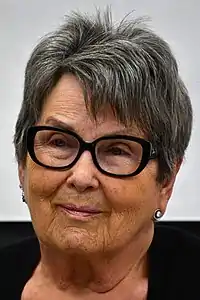Hazel Belvo
Hazel Belvo is an American painter, educator and women's art advocate.
Hazel Belvo | |
|---|---|
 | |
| Born | 1934 |
| Nationality | American |
| Alma mater | Dayton Art Institute |
Belvo was born in 1934 and grew up on a farm in Centerville, Ohio.[1] She attended Dayton Art Institute. She taught art at St. Paul Academy. She spent her summers in Grand Portage, Minnesota and was an artist-in-residence at the Grand Marais Art Colony, and taught there for many years. She was a co-founder of the Women's Art Registry of Minnesota (WARM). She became Dean of Fine Arts at the Minneapolis College of Art and Design in 2000.[2] She retired as Professor Emeritus at Minneapolis College of Art and Design after teaching for there for 34 years.
Belvo's art engages spirituality, myth, and the feminine, with the study of nature as a prominent theme.[3] Her exhibition Spirit Tree at the Bockley Gallery featured paintings of the Little Cedar Spirit Tree (Manidoo-giizhikens).[4] Her series Transfusion Quartet was based on her experiences waiting for someone having a blood transfusion and the images took on a "metaphysical significance under psychological and physical reality seemed inextricably connected."[5]
Belvo was one of twelve artists profiled in Joanna Inglot's 2007 book WARM: A Feminist Art Collective in Minnesota.[6]
Belvo's work is included in private and public collections including the Minneapolis Institute of Art, Walker Art Center, Weisman Art Museum, Tweed Museum of Art, Bezalel Museum, Dewitt Wallace Collection and General Mills.
Personal life
Belvo was married and had two sons[7] before she met Anishinaabe artist George Morrison at Ohio's Dayton Art Institute. They wed in 1960 and had a son, Briand Mesaba, in 1961.[8][9] They lived in a renovated church in Saint Paul and in the mid-1970s purchased land on Lake Superior near Grand Portage. They named it "Red Rock" and it served as both home and studio for the artists. Belvo divorced Morrison in 1991 and the two remained friends. Morrison died in 2000.[10] Belvo's current partner is artist Marcia Cushmore, they live in MInneapolis and Grand Marais, Minnesota.
References
- Makholm, Kristin; Kinney, Marla J. (2006). Vermillion Editions Limited: A History and Catalogue, 1977-1992. Minneapolis, Minnesota: Minneapolis Institute of Arts. pp. 102, 287. ISBN 0-8166-4972-3.
- Sheehy, Colleen J. (Summer 1997). "Making a Place for Art: 50 Years at the Grand Marais Art Colony". Minnesota History. Minnesota Historical Society Press. 55 (6): 264–265. JSTOR 20188036.
- Inglot, Joanna (2007). Westlund, Laura (ed.). WARM: A Feminist Art Collective in Minnesota (1st ed.). Minneapolis: Weisman Art Museum. p. 86. ISBN 978-0-8166-5038-5.
- Abbe, Mary (April 11, 2013). "Art spotlight: Hazel Belvo at Bockley Gallery". Star Tribune.
- Lauter, Estella (1984). Women as Mythmakers: Poetry and Visual Art by Twentieth-Century Women. Indiana University Press. p. 141. ISBN 0-253-11502-7.
- Gardner-Huggett, Joanna (Spring 2008). "Reviewed Work: WARM: A Feminist Art Collective in Minnesota by Joanna Inglot". Woman's Art Journal. 29 (1): 65. JSTOR 20358154.
- Anthes, Bill (2006). Native Moderns: American Indian Painting, 1940–1960. Durham: Duke University Press. p. 109. ISBN 0-8223-3866-1.
- Montiel, Anya (Summer 2005). "The Art of George Morrison and Allan Houser: The Development and Impact of Native Modernism". American Indian Quarterly. University of Nebraska Press. 29 (3/4): 481. doi:10.1353/aiq.2005.0099. JSTOR 4138984. S2CID 162306958.
- Regan, Shelia (May 6, 2013). "Hazel Belvo and the "Spirit Tree" at Bockley Gallery". City Pages.
- Riddle, Mason (January 31, 2010). "An appreciation of George Morrison, a brilliant local artist who hung out with Jackson Pollock, who taught at Cornell and RISD, and who happened to be Native". Twin Cities Daily Planet.
Further reading
- Inglot, Joanna (2007). Westlund, Laura (ed.). WARM: A Feminist Art Collective in Minnesota (1st ed.). Minneapolis: Weisman Art Museum. pp. 86–89. ISBN 978-0-8166-5038-5.CS1 maint: ref=harv (link)